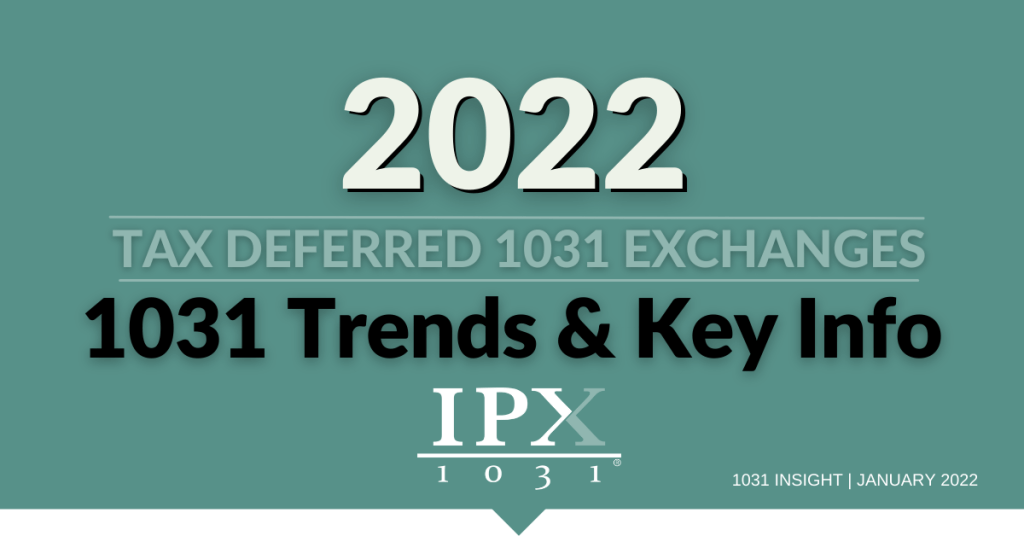As we start this New Year, below are key trends, issues and points to remember regarding 1031 Exchanges.

1031 Exchange Trends and Market Update 2022
1031 Exchange transaction record setting continued in 2021. What’s in store for 2022?
Despite suffering setbacks during the pandemic in 2020 and 2021 and the ongoing level of uncertainty from the effects of COVID-19 and its variants, the CRE industry has a positive outlook heading into 2022 and 1031 intermediaries anticipate another strong year.
Access to capital remains quite good, spurring strong buyer demand as investors rush to take advantage of the current lending environment, while private equity and real estate investment firms have been stockpiling cash. Multifamily and industrial remain the popular asset classes, and retail and hospitality sectors all may see increased 1031 investment this year.
Across the US, pandemic-associated shifts in personal/professional behavior and decisions are triggering unevenly distributed changes in space demand. The new normal will be bridging the gap between home and work with flexibility in how space is used, built or repurposed. Fundamental changes in working from home, hybrid and office are likely to persist and even accelerate in coming years.
Many newer or renovated properties with modern amenities such as more collaborative spaces and highly integrated technology will benefit from work changes. Older properties in low-growth sub-markets that may be ill-equipped for the future of work, may face obsolescence, potentially making these properties prime for a 1031 Exchange, placing them in the hands of buyers ready for repurposing, renovating and reimagining the real estate.
As COVID and variant challenges subside, the hospitality sector, particularly boutique resorts and extended-stay properties, is expected to rebound as business and leisure travel increases. More office and retail spaces will be readapted to health or life science type spaces, spurred by vaccine and drug R&D.
A very positive outcome was that limitations to IRC Section 1031 were not included in the 2021 House-passed version of the Build Back Better bill (BBB). As we roll into Q12022, we continue to watch BBB progression, in whatever form that may take, monitoring any changes to provisions and Pay-Fors. We also will be watching for the Administration to issue its proposed budget within the coming months and remain prepared to respond to any threats to IRC Section 1031. We remain highly engaged in the critically important work of proactively educating our policy makers to the legitimate, economically important benefits of Section 1031.
Again, another strong year for 1031 Tax Deferred Exchange transactional activity is anticipated in 2022 as borrowing rates remain low, repurposing and renovating commercial real estate activity remains high, and interest in single family dwelling investments continues to grow.
1031 Exchange trends for 2021 we are anticipating:
- Passive income 1031 solutions like fractional ownership of properties (known as a DST) and Triple Net Lease as Replacement Property have never been this popular and will continue to rise.
- 1031 identification challenges with a continued shortage of Replacement Property inventory and a competitive market, increasing Reverse Exchange transactions to an all-time high.
- More investors exchanging 1-4 family residential and replacing with commercial or mixed-use properties that provide both a primary residence and rental investment, or raw land as 1031 Replacement Property and Build-to-Suit Exchanges where improvements are made to Replacement Properties as part of the like-kind exchange.
- Investors looking for the new up and coming markets to buy Replacement Property as markets such as the Carolinas, Austin, Texas and Idaho become more expensive and saturated.
- Continued increase of qualifying vacation home rental property purchases in warmer climates or other vacation or remote-working locations with high short-term rental income.
- Individual exchangers in larger and higher tax states like California and New York, selling investment property and relocating assets and/or themselves to tax friendlier states.
2022 Capital Gains Tax Brackets
1031 Exchange Checklist
Tax Straddling: Pay Taxes in 2022 or 2023?
If your transaction closed at the end of 2021 and you are unable to find new property to identify or purchase the property that you have identified, you may still be able to defer paying taxes on your capital gains until 2022. Since you will receive your 1031 funds back in 2022, in certain circumstances, since you did not have control/possession of your funds until 2022, the IRS may allow you to pay taxes on your 2022 tax return, which are due in 2023. This is in accordance with IRC Section 453(d) and requires your accountant to file specific tax forms. Ask your accountant if you are eligible to take advantage of this “mini” tax deferral.
IPX1031 – Choose the Experts
IPX1031 is the largest and one of the oldest Qualified Intermediaries in the United States. As a wholly owned subsidiary of Fidelity National Financial (NYSE:FNF), a Fortune 500 company, IPX1031 provides industry leading security for your exchange funds as well as considerable expertise and experience in facilitating all types of 1031 Exchanges. Our nationwide staff, which includes industry experts, veteran attorneys and accountants, are available to help you and your legal and tax advisors. For additional information regarding IPX1031 and questions on 1031 Exchanges, please review:
1031 Exchange and Defer? Or Sell and Pay Taxes?
Opportunities of the 1031 Exchange
How Important is Your Qualified Intermediary?
Capital Gains Estimator
IPX1031 Knowledge Center
Read PAST years’ 1031 trends
1031 Exchange Trends 2021
1031 Exchange Trends 2020
1031 Exchange Trends 2019
1031 Exchange Updates & Impacts 2018
1031 Exchange Trends for 2017
1031 Exchange Trends for 2016
